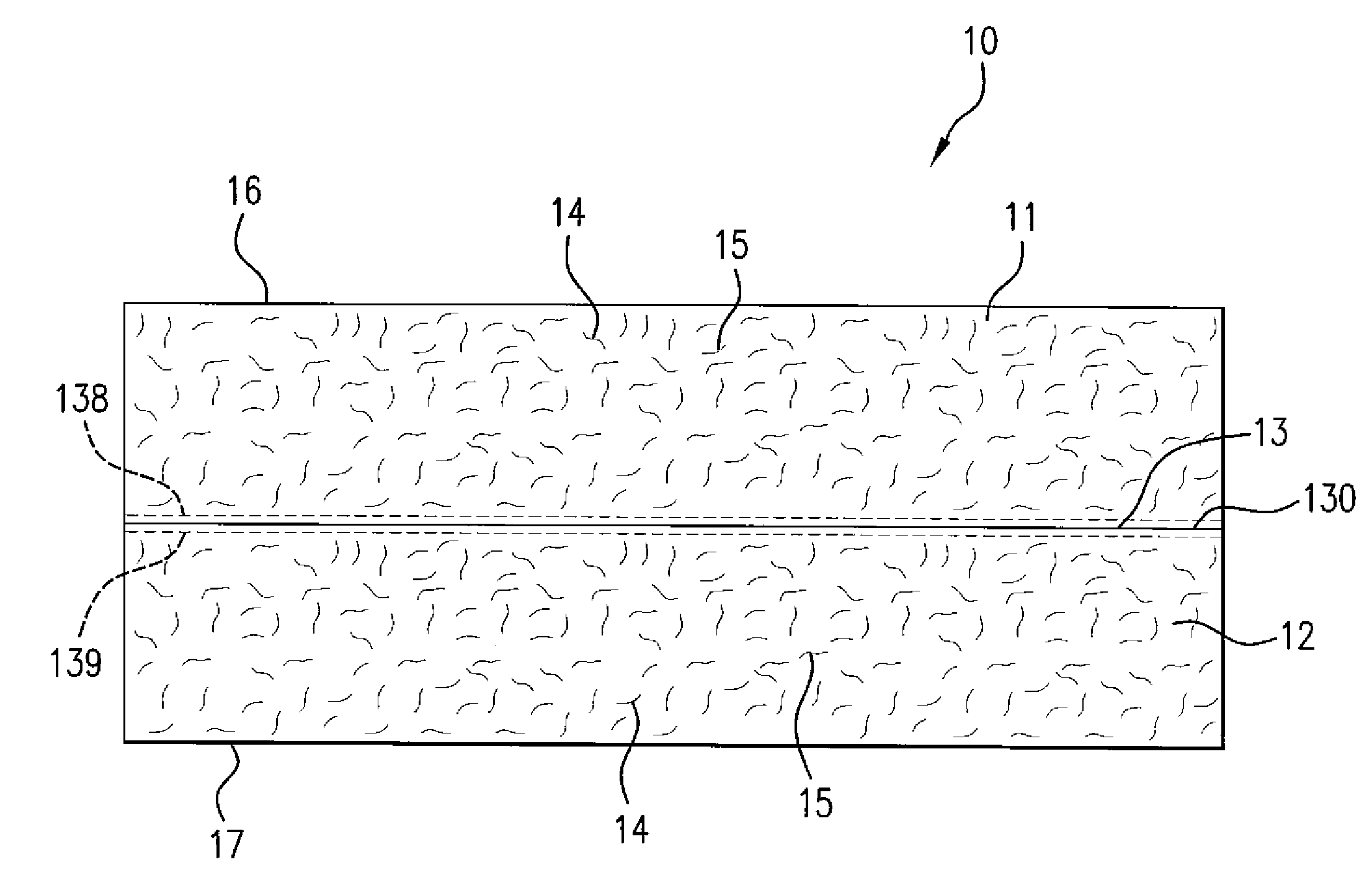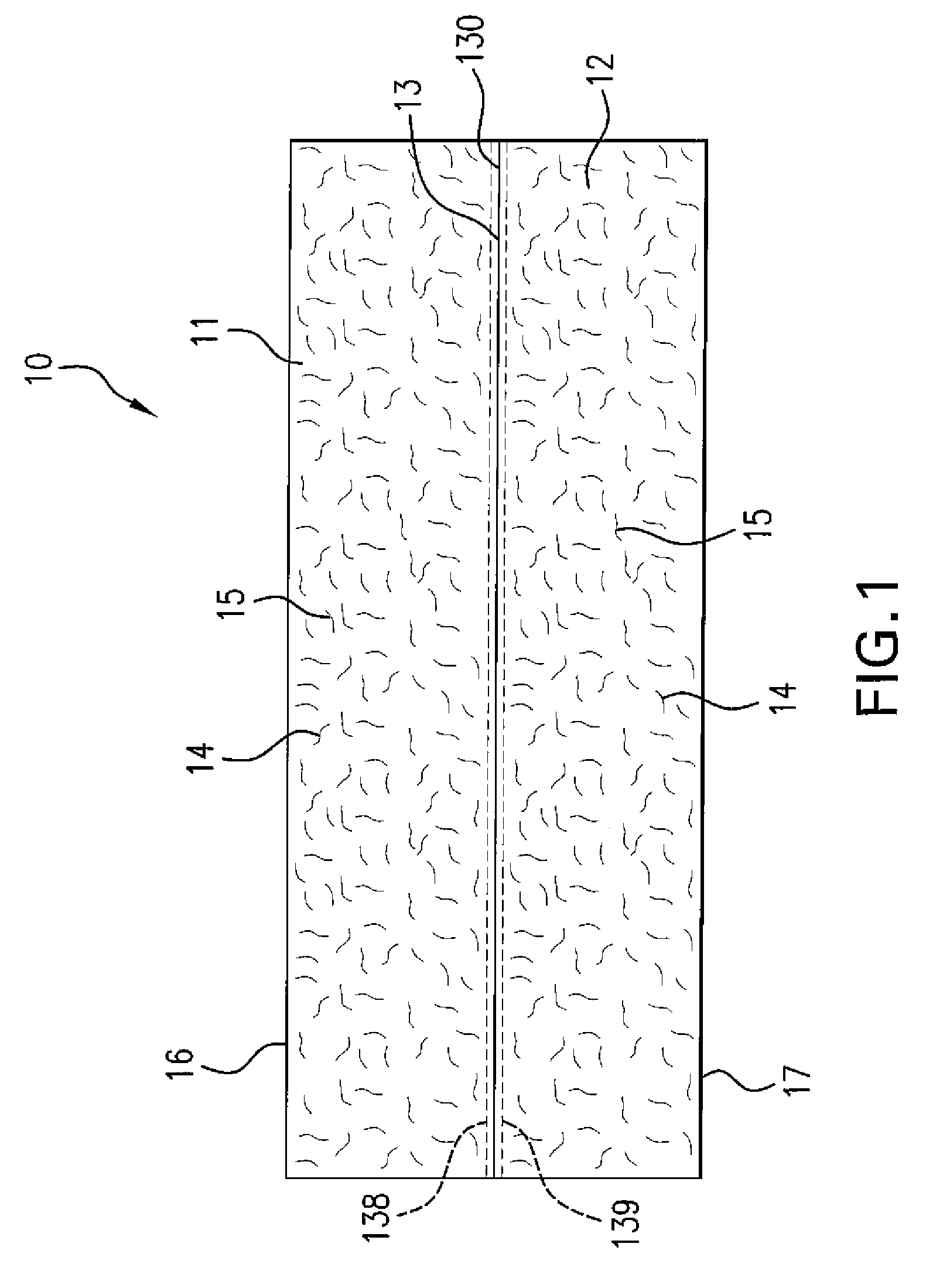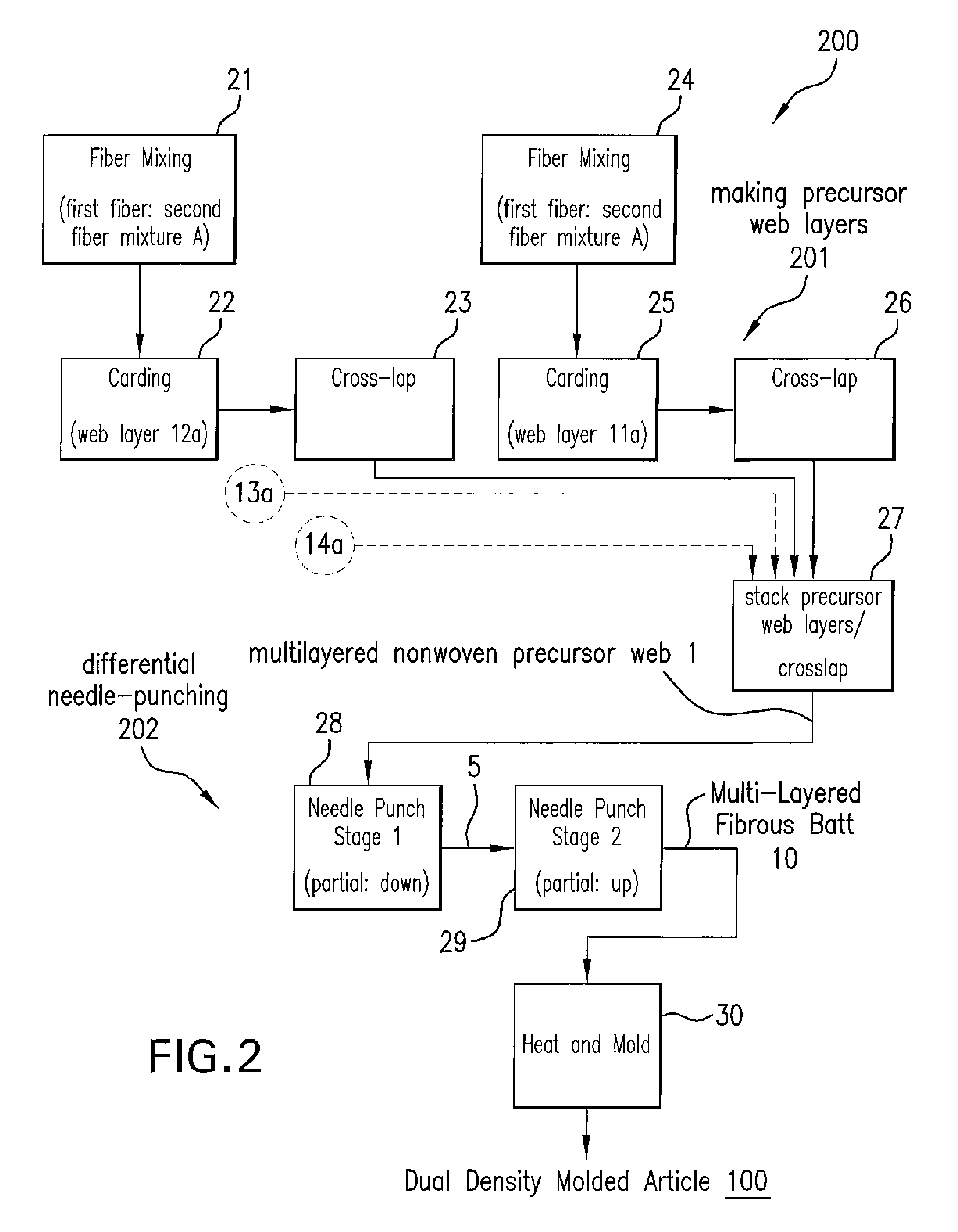[0012]With fibrous batts of the present invention, it is possible to custom mold a wide variety of multi-density molded articles having desired acoustical properties from a single nonwoven fibrous multilayered thermal compression moldable batt of the present invention. By controlling molding thickness, for example, the nonwoven multilayered fibrous batts constructed in accordance with various embodiments of the present invention can be custom molded in a single molding step into multi-density parts tailored to provide different balances of sound transmission loss and sound absorption properties. Further, the nonwoven multilayered batts can be custom molded in a single molding step into a wide variety of multi-density parts without need for redesigning the thermal compression moldable fibrous batt of the invention. In addition, the first and second fibrous batt layers of the nonwoven multilayered fibrous thermal compression moldable batt can be consolidated into a unitary nonwoven multilayered batt structure without need of any extraneous adhesive binders, preform fusion bonding or annealing. The first and second types of fibers also can comprise substantially the same or different fiber finish. In addition, the constituent batt layers can be formed using only two different types of fibers. These features reduce production costs and complexity.
[0013]In another embodiment, a process is provided for making a nonwoven multilayered thermal compression moldable fibrous batt comprising forming first and second precursor web layers comprising blends of first and second discontinuous fibers in different proportional amounts, wherein the first discontinuous fiber melt point is at least 30 degrees Celsius less at ambient conditions than the melt point of the second discontinuous fiber. In further embodiments, first and second precursor web layers can comprise blends of first and second discontinuous fibers in different proportional amounts, wherein the first discontinuous fiber melt point is at least 60 degrees Celsius less, or is at least about 80 degrees Celsius less, or is at least 100 degrees Celsius less, at ambient conditions than the melt point of the second discontinuous fiber. The precursor web layers are overlaid to form a nonwoven precursor web that is needle punched from opposite sides to unite the first and second precursor web layers and to form an intertufted region between opposite sides of the needled punched nonwoven precursor web, thereby forming a nonwoven multilayered thermal compression moldable fibrous batt with substantially uniform density. The needle punching can be conducted simultaneously or sequentially in separate stages from opposite sides of the nonwoven precursor web. Needle penetration depths from both sides extend partially through the thickness of the nonwoven precursor web to form the intertufted region between the opposite outer surfaces of the web that joins the batt layers via an intertufted region. The needle punching equilibrates the densities of the precursor web layers and the density of the needled thermal compression moldable batt is made substantially uniform. In various embodiments, the first and second precursor web layers can have basis weights that differ by more than about 10%, or at least about 25% and no more than about 50% prior to the needle punching, and yet can be needle punched into a batt having substantially uniform density by methods of the present invention. A needle punched multilayered batt is provided in which the precursor layers do not need to be individually needle punched or molded before they are joined into a unitary fibrous batt. The fiber proportions used in the first and second fibrous batt layers can be similar to those described herein with respect to the precursor web layers.
[0014]The resulting needle punched nonwoven multilayered fibrous batt having uniform density can be thermal compression molded into various acoustical parts in a one-step molding process. The molded parts can be fabricated using batts according to embodiments of the present invention which are formed predominantly or essentially completely with recyclable, environmentally-friendly materials. Further, the nonwoven multilayered fibrous batts can be used, for example, as blanks for making vehicle liners that absorb sound and reduce noise in the interior compartment of a vehicle. Also, the nonwoven multilayered fibrous batts can be used to form lighter molded parts than traditional plastic parts, making it possible to manufacture more efficient vehicles that consume less fuel. Another advantage of the nonwoven multilayered fibrous batts of the present invention is that they can provide improved acoustic properties in parts molded to thinner thicknesses.
[0015]By adjusting molding thickness imparted to the molded part, for example, it is possible to custom form molded parts having significantly different balances of acoustical properties from the same or similar starting multilayered fibrous batts of the present invention. In one embodiment, a dual density molded article, when made from the same starting multilayered batt material according to embodiments herein, exhibits a different balance of sound absorption and sound transmission loss properties, depending on the molded part thickness that is formed. For example, at a molded thickness of about 9 mm to about 11 mm, a dual density molded part made from the nonwoven multilayered batts of the invention can exhibit a sound transmission loss of about 1 to about 5 (dB), a primary absorption peak in the range of about 0.65 to about 0.75 between 4000 to 5000 Hz and an airflow resistance of about 200 Rayls to about 450 Rayls. By comparison, a dual density molded part made from the same multilayered fibrous batt at a molded thickness of about 3 mm to about 7 mm, can exhibit a sound transmission loss of about 10 to about 15 (dB), a primary absorption peak in the range of about 0.5 to about 0.6 between 2500 to 5000 Hz and an airflow resistance of about 2000 Rayls to about 4500 Rayls. Thus, the nonwoven multilayered batt is a highly versatile starting material allowing a molder to mold the starting batt to a thickness providing the best match with the specified or desired balance of acoustical properties for the molded part or component.
 Login to View More
Login to View More 


